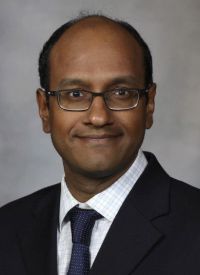News
Article
Atezolizumab/Bevacizumab Represents Potential Therapeutic Option in Child-Pugh B7 HCC
Atezolizumab plus bevacizumab showed efficacy in patients with hepatocellular carcinoma who had Child-Pugh B7 liver function.
Amit Mahipal, MPH, MBBS

Although overall survival (OS) and progression-free survival (PFS) benefits observed with atezolizumab (Tecentriq) plus bevacizumab (Avastin) are greater in patients with hepatocellular carcinoma (HCC) who have Child-Pugh A liver function, the combination remains an option for patients with Child-Pugh B7 liver function, according to data from a multi-institutional cohort study presented at the 2024 ASCO Breakthrough Conference. Additional findings from the study, which were presented by Amit Mahipal, MPH, MBBS, revealed that responses rates appear similar in those with Child-Pugh A and Child-Pugh B7 liver function.1
The median OS was 21.6 months (95% CI, 17.7-34.9) among patients with Child-Pugh A liver function (n = 226) treated with atezolizumab plus bevacizumab compared with 6.4 months (95% CI, 5.2-9.0) for those with Child-Pugh B liver function (n = 86) and 2.5 months (95% CI, 0.4-not evaluable [NE]) for patients with Child-Pugh C liver function (n = 10). The respective 12-month OS rates were 69.3% vs 32.4% vs 10.0%. The median PFS was 8.9 months (95% CI, 6.8-11.0) vs 4.8 months (95% CI, 2.7-6.7) vs 2.5 months (95% CI, 0.4-NE), respectively.
Additionally, 45.7% of patients with Child-Pugh B7 liver function (n = 49) were alive at 12 months. Upon further OS examination by Child-Pugh B class, patients treated with atezolizumab plus bevacizumab with B7 liver function experienced a median OS of 9.1 months (95% CI, 6.4-14.9) vs 4.7 months (95% CI, 2.6-6.1) among those with Child-Pugh B8 to B12 disease (n = 47). The median PFS was 6.4 (95% CI, 4.6-11.6) months vs 2.7 months (95% CI, 1.8-4.9), respectively.
“Outcomes in Child-Pugh B7 [class disease] are significantly different than Child-Pugh B8 or B9 [class disease],” Mahipal, the Ruth and Donald Goodman Chair in GI Oncology at UH Seidman Cancer Center in Ohio, and coauthors noted.
Mahipal and coauthors added that atezolizumab plus bevacizumab is the preferred first-line treatment option for patients with advanced HCC based on data from the phase 3 IMBrave150 trial (NCT03434379). Although findings revealed patients treated with the combination therapy experienced improved OS compared with sorafenib (Nexavar), the trial only enrolled patients with Child-Pugh A liver function.2
Therefore, this multi-institutional cohort study was conducted with the primary objective of comparing OS outcomes in patients with advanced HCC who had Child-Pugh A vs Child-Pugh B liver function; a focus was also placed on evaluating the regimen in those with Child-Pugh B7 liver function. Secondary objectives included comparing PFS, response rates, and adverse effects (AEs) among different Child-Pugh score groups.1
The multi-institutional retrospective analysis included data from patients treated at University Hospitals Seidman Cancer Center and Mayo Clinic. The study took place at over 20 centers of academic and community-based practices in Minnesota, Wisconsin, Ohio, Arizona, and Florida. Patients with advanced HCC who were not amendable to receive locoregional therapy and who intended to receive atezolizumab plus bevacizumab as first-line systemic therapy were included in the analysis.
Baseline patient characteristics were generally well balanced between those with Child-Pugh A and Child-Pugh B liver function. The median age at diagnosis was 66.5 years (IQR, 61.0-72.0) among all patients in the study (n = 322); most patients were male (78.6%) and White (82.6%). Additionally, most patients did not have macrovascular invasion (57.1%), extrahepatic metastasis (69.6%), hepatitis B (94.7%), or hepatitis C (65.2%). Mahipal noted that macrovascular invasion was a bit higher in those with Child-Pugh B liver function at 52.3% vs 38.5% for those with Child-Pugh A liver function.
Further data from the trial revealed that patients with Child-Pugh A (4.4%), B (1.2%), and B7 (2.0%) liver function achieved complete responses, but those with B8-9 (n = 37) or C liver function did not. Partial responses were observed in those with a Child-Pugh liver function of A (29.2%), B (19.8%), B7 (30.6%), B8-9 (5.4%), and C (10.0%). Disease progression occurred in 28.3% vs 43.0% vs 30.6% vs 59.5% vs 50.0% of patients, respectively.
Regarding safety, immune-related AEs occurred in 15.0% of patients with a Child-Pugh A class disease and 18.6% of patients with a Child-Pugh B class disease. Fatigue occurred in 61.1% vs 61.6% of patients, and bleeding in 10.2% vs 16.3%, respectively; notably, bleeding AEs were grade 3 or higher in 11.3% of patients with Child-Pugh B liver function. Grade 1 (12.4% vs 10.5%), 2 (5.3% vs 2.3%), 3 (4.4% vs 1.2%), and 4 (0.4% vs 0.0%) hypertension also occurred in patients with Child-Pugh A and B liver function, respectively. Two patients with Child-Pugh A liver function experienced a grade 5 immune-related AE.
“[There was] no increase in rates or severity of immune-related AEs in patients with Child-Pugh B [liver function and] no significant higher risk of bleeding,” Mahipal and coauthors concluded.
References
- Mahipal A, Zemla TJ, Patell K, et al. Multiinstitutional cohort study of patient outcomes in Child-Pugh (CP) B liver function treated with atezolizumab plus bevacizumab (A+B) for hepatocellular carcinoma (HCC). J Clin Oncol. 2024;42(suppl 23):50. doi:10.1200/JCO.2024.42.23_suppl.50
- Finn RS, Qin S, Ikeda M, et al; IMbrave150 Investigators. Atezolizumab plus bevacizumab in unresectable hepatocellular carcinoma. N Engl J Med. 2020;382(20):1894-1905. doi:10.1056/NEJMoa1915745









